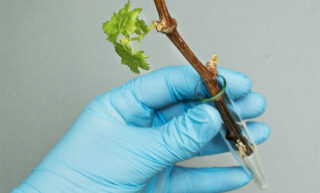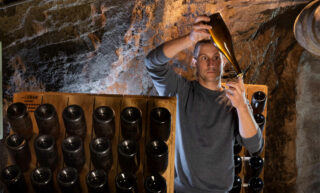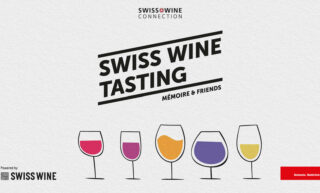Ziereisen Crosses a New Line
“Winemaking is like archery,” Hanspeter Ziereisen, the cult German vintner, told me recently. “You take the bow, carefully nock the arrow, pull it back, and aim the shot. Then you release.” It was his way of saying quality is made in the vineyard, but a restrained approach in the cellar is required to unleash it.
Ziereisen, based in Efringen-Kirchen in the Markgräflerland subzone of Baden, trained as a carpenter. A change of heart prompted him to take over his parents’ mixed farm and specialize on grape growing and winemaking, which, apart from some short internships, he learned by doing.
He shot to fame in 2006 when he stopped handing in his wines for the amtliche Prüfung, Germany’s official wine inspections. His wines were often too individualistic to pass the standard tasting test. He refused to compromise on his vision. For his white wines in particular, he uses a bit more extraction to allow the young wines to rest on the full lees for an extended period. Ever since, he has sold his wines as Landweine. It gives him the freedom and flexibility to let his wines develop the way they want.
Ten years ago, Ziereisen embarked upon a new project. He took a lease from the local village council of Riehen on Weingut Riehen just over the border in the canton of Basel-Stadt, Switzerland — not to become a ‘Swiss’ winemaker, as he says, but to support and coach one of his Swiss employees, Thomas Jost, who wanted to start his own winery. In the process, Ziereisen and his new venture are giving the somewhat sleepy wine scene in northwestern Switzerland a welcome shake-up.
The village of Riehen used to have extensive vineyards, but the expanding city of Basel has encroached on the surface area, nearly wiping it out. When the village council decided to prioritize viticulture, they started looking for someone who could revive the fortunes of the village-owned winery. An offer from Jost and Ziereisen won the day.
When Jost left the project four years later, Ziereisen — unable to take on another winery in addition to his own 25 hectares in Efringen — had to find a replacement. Enter Silas Weiss.
Silas Weiss in his barrel cellar in Riehen
Weiss, born in the U.S., grew up in Switzerland’s Pinot-center of Neuchâtel in a German-speaking family. At 16, he chose to enter the popular system of vocational training combining academic learning with on-the-job experience. Although Weiss’s family had no direct links to winegrowing, vines were always close by.
After internships in Switzerland and California, Weiss started working for Paul Ullrich AG, one of Switzerland’s main wine importers and retailers, to learn the commercial side of the trade. Just as Weiss felt he had gained enough experience, Ziereisen was ready to hire.
As Swiss law restricts the ownership or lease of land in Switzerland by non-Swiss citizens, Ziereisen was also looking for a partner. Enter Urs Ullrich, the current owner of Paul Ullrich AG.
Together Ziereisen and Ullrich created the ideal setting for a talented young winemaker to pursue his dream. Ullrich handles all the administration so that Weiss can develop his skills in the vineyard and cellar, where he does all the work by himself, except during harvest, when he has a team of volunteers. (Full disclosure: your reporter was part of it in 2023.)
Ziereisen coaches Weiss on viticulture and takes care of exports. A sounding board and sparring partner rather than a tutor, Ziereisen applies the same hands-off approach towards coaching that he uses in the cellar. When Ullrich introduced Weiss to Ziereisen, it took only a short conversation and a few days of working together for Ziereisen to see Weiss’s potential. As he knows they are operating on the same wavelength, he only needs to give Weiss minimal guidance.
Terroir v. Terroir
As might be expected, Weiss’s and Ziereisen’s approach is essentially the same — no herbicides, spontaneous fermentation, long aging on the full lees, no fining, no filtering, and minimal additions of sulfur — but differences in terroir ensure that their wines aren’t identical.
Ziereisen’s own winery is just 10 kilometers away, but the geological makeup of the landscape is different. The Rhine Valley is a Graben or rift valley. The calcareous Jura Mountains, which form the border between France and Switzerland, actually dive under the river to resurface on the German side before merging with the granitic and sandstone Black Forest. Although both wineries are based in Jurassic territory, the limestone at Efringen is harder, more crystalline, with little topsoil. On the Tüllingerberg in Riehen, the limestone bedrock is covered by thick layers of clay.
Both the Tüllingerberg (Weiss’s terroir) and the Ölberg (Ziereisen’s) are predominantly south-facing with moderating climatic influence from the Black Forest. The Swiss side of the Tüllingerberg, which is shared with Germany, counts as one of the hottest vineyards in Switzerland and is slightly warmer than the Ölberg in terms of average growing season temperature and maximum temperature, Ziereisen and Weiss explain.
Grape varieties are another difference. While Ziereisen’s hallmarks are Gutedel, Grauburgunder, and Spätburgunder, Weiss grows mostly Chardonnay, Pinot Blanc, and Pinot Noir. (In Switzerland it’s more common to use the French names for grape varieties.)
Weingut Riehen is barely four hectares; Ziereisen’s is more than six times that. Weiss makes six wines divided over three tiers: l’Unique (comparable to village wines), Le Petit (premier cru/Erste Lage), and Le Grand (grand cru/Grosse Lage). Weiss’s Le Grand is made from the best grapes from the Tüllingerberg, often, but not necessarily, from the same parcels. As yet the Tüllingerberg is treated as one Lage, or cru, without an official subdivision into individual parcels.
Ziereisen distinguishes between estate wines, premier and grand crus, as well as monovarietal wines. Jaspis, the top line from his best parcels (Grosse Lagen, if you will) from the oldest vines, are made only in very good years.
His Pinots tend to be leaner and more mineral; Weiss’s are more opulent and a bit more floral and fruit-forward. However, the difference is most obvious when tasting Ziereisen’s premium Steingrüble Gutedel side-by-side with Weiss’s Le Petit Pinot Blanc. The Steingrüble is almost ethereal, with a surprisingly low 10% alcohol by volume, yet it loses none of its power or intensity, whereas Le Petit is more structured, yeasty, and full-bodied.
On the other hand, when you taste Ziereisen’s topline Jaspis Gutedel 104 alongside Weiss’s Chardonnay Le Grand there is a clear similarity — texture and body feel, if not identical, then certainly related.
The Perfect Wine?
Over the last five years, Weiss has been nurtured from a promising to a successful vintner. Last year, in a blind tasting of 45 of the best Chardonnays from Switzerland and other parts of the world, Weingut Riehen’s Chardonnay Le Grand came out on top, prevailing over the likes of Kongsgaard, Leeuwin, Donatsch, and Louis Latour.
Weiss’s success has attracted attention, for now mostly from within Switzerland. Colleagues are curious to find out how he manages such long maturation times. The financial implication of it, but also his laissez-faire attitude (a key factor in his winemaking), prompt inquisitive questions.
It makes Weingut Riehen a welcome addition to northwestern Switzerland’s small wine scene. The joint area of Basel-Stadt and Baselland counts just 118 hectares of vineyards, consisting of two appellations and a handful of wineries that stand out, among which Jauslin (the standard bearer for the region within the prestigious group of Mémoire des Vins Suisses wineries that focuses on crafting wines with longevity) and KLUS177 (the only certified biodynamic winery).
However, Weiss’s ambitions go beyond Basel. With his wines on almost all the Michelin-starred restaurants in the region, his next goal is to conquer the rest of the country. Meanwhile, he takes advantage of Ziereisen’s network that facilitates the export of a small number of his wines to the U.S. But as with most Swiss wineries, sales are predominantly domestic.
Le Voisin Blaufränkisch, Deutscher Qualitätswein
Two years after he joined forces with Ziereisen, Weiss took a 40% stake in Weingut Riehen, while Ziereisen and Ullrich own 30 percent each. For all practical purposes, Weiss runs the winery. It is just a matter of time before he will be granted a majority share, so that he will eventually have his own winery, and Ziereisen’s role as a coach will come to its natural end. As Ziereisen has recently acquired four more hectares in Efringen, all manually farmed, he’ll be less available to pitch at Weingut Riehen anyway.
Although the largest credit for Weingut Riehen’s success should go to Weiss, a good part is Ziereisen’s due. And that is not because Ziereisen claims to know everything. He surely is experienced and widely respected. But true wisdom also comes with the humble acceptance that trends and circumstances change continuously, and one never finishes learning.
And the perfect wine? It probably doesn’t exist. “As long as you hit the target, it’s fine, you don’t need to hit the bull’s eye,” Ziereisen said. “You always end up wondering what you could have done differently anyway. Should I have harvested earlier or later? Should I have done more or less green harvesting? Should I have left fewer or more leaves on the vines? Should I have soaked the grapes longer or shorter?”
That said, the 2013 vintage may have possibly been dead center, he admits. That was more than ten years ago. But Zieriesen accepts that as part of the vintner’s life. A wise lesson.
The Ultimate Umlaut Wine
Meanwhile, Weiss has embarked on a new project. He leases a small vineyard on the German side of the Tüllingerberg, contiguous with his Swiss vineyards. It is planted to Blaufränkisch — an unusual choice for this corner of the wine world. Because he currently doesn’t own the required two-thirds stake in the winery, he cannot legally operate an agricultural business and hence cannot import grapes. To break the impasse, Weiss ferments the must at Ziereisen’s winery and imports the young wine (legally) into Switzerland. (Yes, Swiss laws can be unfathomable.)
Subsequently, the wines age for three years in Weingut Riehen’s cellar, after which they are registered in Freiburg (Germany) for the Qualitätsprüfung or quality inspection, so that vintage and variety may be mentioned on the label. Eventually, the wine is marketed as Le Voisin, Deutscher Qualitätswein from Weingut Riehen — a German wine made from an Austrian grape variety by a Swiss vintner. Had it been given a South Tyrolean name, it might have been the ultimate umlaut wine.
This article was published in TRINK magazine volume 18, January 2024. TRINK is an American online magazine dedicated to the wines from the German speaking world.








Comments